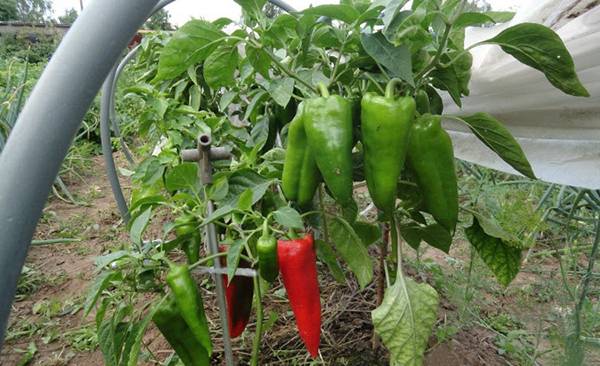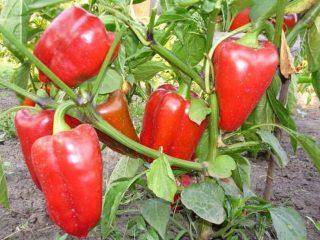Sweet peppers are among the most commonly grown vegetables in our country. Even despite the exactingness of the conditions of care, the popularity of this vegetable is only growing every year. The main reason for this is the taste and health benefits of its sweet fruit. There are quite a few varieties of this culture, but several dozen of the most popular stand out among them. One of them is the sweet pepper variety Volovye ear.
Characteristics of the variety
This sweet pepper is one of the best mid-season varieties. The harvest of its peppers will reach technical maturity in 96-100 days, and the whole cycle until the fruit is fully ripe will take about 125 days.
Plants are of medium size, their height will not exceed 70 cm.
Pepper's ear in its shape resembles an elongated cone. Its dimensions are quite large: the length can vary from 12 to 16 cm and weigh up to 200 grams. During the period of technical maturity, the fruits of this variety have a dark green color, and upon reaching biological maturity, they are deep red with a glossy sheen.
This sweet pepper has a rather fleshy pulp with a wall thickness of 6-7 mm. Its distinctive feature is that it does not taste bitter even when unripe. This variety of pepper has versatile uses. It is equally good in salads and homemade preparations. According to the majority of housewives, Ox ear is an ideal variety for home lecho.
This sweet pepper variety has excellent resistance to many diseases, especially the tobacco mosaic virus. He has a fairly high and stable yield. If agrotechnical recommendations are followed, up to 3 kg of crop can be harvested from one square meter. Cow's ear belongs to those varieties that retain their marketable and taste qualities well during storage and transportation.
Growing recommendations
Sweet peppers of this variety are grown through seedlings. They begin to cook it in mid-March.
This technique will allow young plants to immediately accustom themselves to the soil where they will have to grow, thereby minimizing the stress from transplanting.
The process of preparing seeds for seedlings of the Volovye Ukho variety includes several stages:
- Selection of live seeds. To do this, all the seeds are immersed in water, and the floating dummy seeds are selected. They do not contain a sprout, so you should not plant them.
- Soaking the seeds for several days.
- Treatment of seeds with a weak solution of potassium permanganate, followed by washing them with warm water.
Seeds that have undergone such training will be able to sprout faster, and will already have a certain immunity. They are planted in a pre-prepared substrate, after which they are covered with a film until shoots appear.
Therefore, it is better to plant seeds in separate containers, 2-3 pieces each. After emergence, weak shoots must be removed, leaving one strong one.
Ready-made vegetable seedlings of this variety can be planted both in open beds and in a greenhouse. When disembarking, it should be borne in mind that the best predecessors will be:
- siderates;
- legumes;
- cucumbers;
- all cruciferous plants and others.
It is not recommended to plant seedlings of the Volovye Ukho variety after tomatoes. And if there are no other options, then in the fall you need to dig up the ground with any organic fertilizer.
Otherwise, the requirements for the care of this variety are the same as for all peppers:
- Lots of light and warmth. Moreover, if the peppers are planted in a greenhouse, then airing is necessary. If this is not done, then the flowers and ovaries will crumble from the plants.
- Watering with warm water. Watering frequency depends on weather conditions, but not less than 2 waterings per week. Before flowering, rain watering is preferable, and from the beginning of flowering to the end of the growing season only at the root. The rate is from 1 to 2 liters of water per plant.
- Regular loosening and weeding. You can skip this step of leaving if you mulch the bed with pepper plants.
- Top dressing with mineral and organic fertilizers. Good results are obtained by using poultry manure, slurry, and superphosphate.
If these recommendations are followed, the Volovye Ear variety will bear fruit abundantly until the end of September.
You can learn more about growing sweet peppers from the video:











